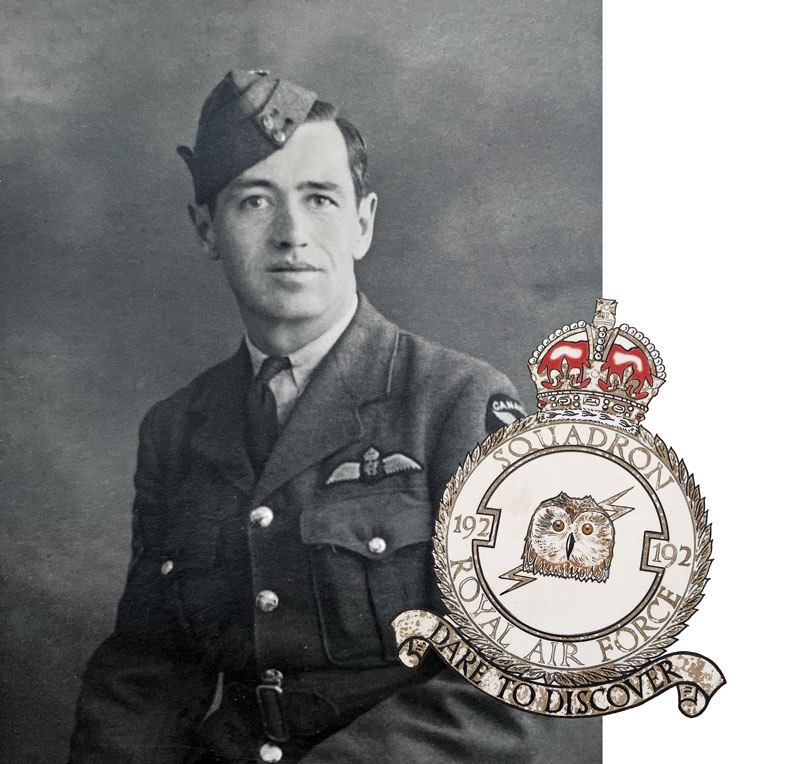
On a bitter cold evening in 1944, eight men took off from Royal Air Force station Foulsham in Norfolk, England, in a four-engine Handley Page Halifax heavy bomber and ascended 6,100 metres into the dark. Rear Gunner Bernard (Bernie) McNicholl sat silent and alone in his Perspex dome, scanning the sky for any sign of a flitting shadow. Three years prior, the 15-year-old was itching to finish high school in Montreal. Now he waited for the enemy to appear—poised to fire four Browning guns that protruded like stingers from the plane’s tail.
From his turret, McNicholl could usually spot enemy aircraft 350 metres away. Suddenly a crew member yelled: “Fighter coming in on us!”
“Corkscrew, starboard, go, go, go!” McNicholl roared into his headset. The bomber plummeted to the right and dove, rolling 60 degrees in the opposite direction before once again starting its ascent.
“What was that?” the pilot’s voice crackled over the intercom.
“There’s good news and bad news,” McNicholl replied.
The good news: the Allied bomber had just flown by a German night fighter. The bad news: “The fighter pretty near crashed into us,” said McNicholl. “I bet you we were 10 feet apart.”
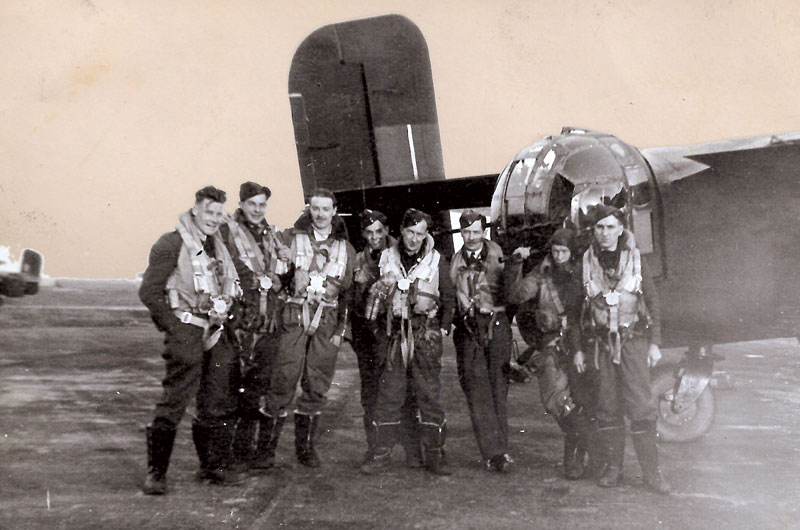
McNicholl and my grandfather Arnold Smith—“Smitty” to his crew and family—were among hundreds of Canadians who served with the Royal Air Force during the Second World War. I knew very little about my grandfather’s RAF career when I was growing up beyond the simple fact that he was a bomber pilot. So, in the fall of 2018, I drove from my home in Vancouver to Chilliwack, B.C., to visit then 92-year-old McNicholl to learn more. (McNicholl died this past July.)
When I arrived at McNicholl’s home, a small, animated man swung open the door and ushered me inside. I had met him only once before, when I was a child, but he immediately felt like family. As we made our way to the living room, he grabbed something off the kitchen table to show me. It was a Halifax bomber model he had built.
McNicholl and Smitty met in Lossiemouth, Scotland, in early 1944. As the youngest crewman, McNicholl looked up to Smitty and the pair bonded quickly. Both had no siblings and had had difficult childhoods.

They flew with 192 Squadron in special duty RAF 100 Group on a top-secret mission: electronic warfare. Their plane carried very few bombs and gathered radar frequency, with a rotating eighth crew member who operated the equipment.
“Every crew thought they were the best crew, but we were, no argument there,” said McNicholl. “Because they used to pick us for the bad trips, too.”
McNicholl spoke highly of my grandfather, a “great low-level pilot” who had never flown a plane before the war. “Smitty didn’t panic,” said McNicholl. “Your grandfather could fly that aircraft like a fighter.”
Smitty, 30 at the time, was one of the eldest on board, and as confident in his aviation skills after less than two years of training as he was in carpentry, a trade he had practised since his teens. Never one to do anything half-heartedly, he was out to impress. Indeed, after meeting a Canadian Red Cross worker—who would become my grandmother—during a stopover in London, Smitty decided to put on a show.
“As we went by Croydon hospital, the ladies were hanging out the windows waving towels at him,” said McNicholl. “When I went by in the rear turret, I was looking up at them. That’s how low we were flying.”
The squadron’s mission was arguably more dangerous than that of many bomber crews, who would fly to a target, drop bombs and go home. After circling for hours collecting frequencies, the data was sent to a jamming squadron to block German radars. While readily scanning for fighters, McNicholl would turn the turret so that it would catch the wind and move the plane. Smitty would correct it to indicate he was awake. Good communication and reflexes were key to their survival. McNicholl says he owes his life to the way his shouted warnings were translated into action by his pilot.
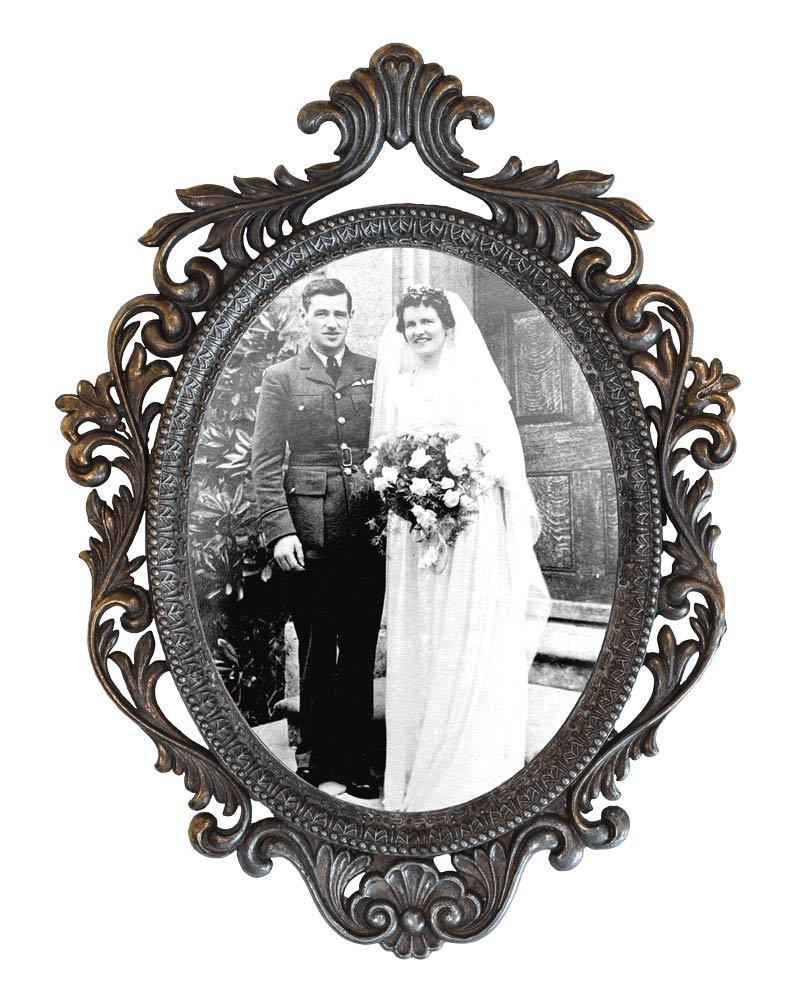
“Smitty was a first-class leader,” said McNicholl. “I’d follow him anywhere.”
Of course, the fact that McNicholl lived to share this tale is momentous: as is well-known, only 25 per cent of bomber crews completed a first combat tour of 30 missions. Remarkably, in June 1945, Papa’s special-ops crew completed, without a casualty, 30 top-secret missions over Germany.
In 1995, a largely intact RAF Halifax bomber was exhumed from the bottom of Lake Mjøsa in Norway and brought to Canada. The 25,000-kilogram plane had been sitting in its boggy grave for some 50 years when Canadian pilot Karl Kjarsgaard began its recovery.
“The Halifax was the most important airplane in [Canada’s] aviation history,” he told me during a visit to the Bomber Command Museum of Canada in Nanton, Alta. “The Lancaster has always got the glory as the beautiful bomber that did everything in World War II,” continued Kjarsgaard, also the museum’s curator. “But Canadians flew 70 per cent Halifax, 20 per cent Lancaster and 10 per cent Wellington.”
Most RAF bombers shot down by the enemy were attacked by night fighters from the rear or underneath. There was no gunner in the belly and it was seen as the weakest point on the plane. McNicholl later learned that this is how the enemy plane had snuck up on them that near-fatal night in 1944.
If RAF crewmen weren’t killed in the air, they were likely to be seriously wounded in crashes or to become prisoners of war. Few in Bomber Command made it to the end of the war unscathed.
Despite the immense losses, Kjarsgaard said the Handley Page Halifax played a huge part in the Allied victory, even if it was overshadowed by the Lancaster heavy bomber. In part, the Merlin engine used in earlier Halifax models couldn’t provide enough horsepower for the plane to perform as designed, garnering it a poorer reputation. In 1942, however, the Halifax Mark III was powered by a Hercules engine and the bomber became a jack of all trades. While the Lancaster could carry more bombs, the new and improved “Halibag,” as it was affectionately known, was ideal for special operations—
as assigned to 192 Squadron.
Kjarsgaard speculated that my grandfather’s crew survived thanks to a combination of chance, talent and teamwork. Still, there’s one thing he’s sure of: “Your family exists because of a Halifax.”
In 1997, my family took my grandfather to the Canadian Warplane Heritage Museum near Hamilton, Ont. I was 10 years old and didn’t fully appreciate the trip’s significance. In one photograph from the visit, my sister and I are standing next to my grandfather in front of an Avro Anson—a plane used for RAF training. My mother captured a rare moment that day: my grandfather—with his white cane in one hand, the other resting on the nose of the plane—grinning from ear to ear.
He was lauded a hero in his hometown of Centreville, N.B, a tiny village northwest of Fredericton, but my mother says her dad never talked about the war. She always knew, however, that he had a special bond with his crew. “The squadron was everything to him,” she told me.
I couldn’t help feeling a twinge of jealousy when I heard that. I longed for the loving relationship my friends had with their grandfathers. Papa Smitty, as I called him, was impatient, short-tempered and extremely fastidious. I constantly tiptoed around him and was, admittedly, a bit scared of him. Even my mother found him intimidating.
As a teenager, when my mom would drive the family car, my grandfather would inspect it upon her return. He would insist she put the seat and mirrors back in the positions she had found them and park it so that the two front wheels sat in the little divots in their gravel driveway. She did her best to please him, but still felt that he didn’t trust her. One time, Smitty secretly put coins on both sides of the dashboard, right up against the window. My mother never noticed until the day she returned home and was asked how fast she had been driving.
“I know I can be a pilot. I’ve been driving a taxi for over a year and a half, and I haven’t killed anybody.”
“You must have been going pretty darn fast,” she recounted him saying. “The coins are on the floor.
“I got to the point where I knew enough to put them back,” she recalled with a laugh, then paused. “I think of that now—he couldn’t have survived the war flying a Halifax bomber if he hadn’t been that precise.”
In 2005, the world’s first restored Halifax was unveiled by Kjarsgaard and his team at the National Air Force Museum of Canada in Trenton, Ont. Smitty, unfortunately, didn’t live long enough to see it. He died less than a year after our trip to Hamilton, at the age of 83.
“My personal tribute to the bomber boys is to save as many Halifaxes as I can,” said Kjarsgaard.
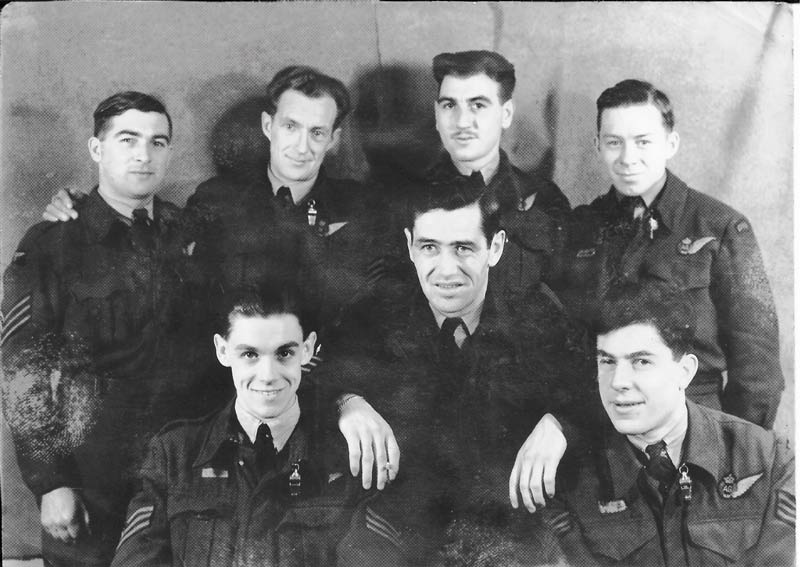
Arnold Smith never dreamt of becoming a pilot. Instead, he became a taxi driver, driving full speed from town to town picking up passengers. To avoid being drafted into the army or navy, the New Brunswick farm boy drove to Moncton, N.B., in the fall of 1942 and enlisted in the Royal Canadian Air Force.
I recently received a package from my mother that held the missing pieces to Smitty’s story. Inside were five compact disks with converted audio recordings from old tapes.
In the 1980s and ’90s, my uncle James Smith sat down with Smitty to capture his wartime memories. When I pressed play, my grandfather’s gruff voice filled my ears for the first time in more than 20 years.
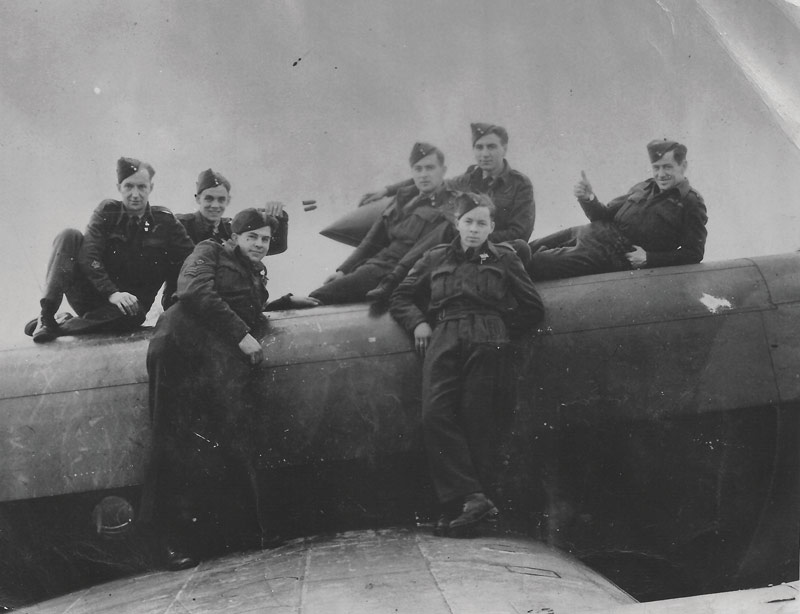
“I said, ‘I want to be a pilot,’” he recalled. “They asked, ‘What makes you think you can be a pilot?’ I said, ‘I know I can be a pilot. I’ve been driving a taxi for over a year and a half, and I haven’t killed anybody.’”
Two weeks after he enlisted, Smitty was on a train to Montreal. He learned to fly on Wellingtons at No. 11 Elementary Flying Training School in Cap-de-Madeleine, Que. He was flown to Lossiemouth shortly before his 30th birthday and assigned the task of finding a crew. All he needed were six people to join him.
“Every crew thought they were the best crew, but we were, no argument there.”
At the time, Smitty had recently injured himself in a bicycle mishap after a night at the pub and thought his banged-up appearance might deter others from wanting to fly with him. He stood idly by for a couple of days until wireless operator Reg Bastow approached him after deciding the other pilots looked too young. Next, they found mid-upper gunner John (Johnny) Matulack and bomb aimer Jack Martin, who, after a few too many drinks, had been left behind by his previous crew.
Meanwhile, aspiring pilot McNicholl had allegedly been grounded for being too dangerous and reckless (or possibly had to re-enlist because he was originally underage), and navigator Ed Moran was even older than Smitty (most crews were in their late teens or early twenties). Unable to find a flight engineer, they picked up Jock Young at the next base. They were a band of misfits, made up of five Canadians, one Englishman and one Scotsman.
“If you want to take a chance it’s all right with me,” Smitty told them.
The crew trained on Halifaxes. When they finished in Lossiemouth, they were granted a seven-day leave before heading to London. But the leave was cancelled.
“Instead of going to London, we were put on another aircraft, a Lancaster—the first and only time I was near one—and flown to the squadron to which we were attached,” Smitty recalled. “And the thing that shook us up, we were an RAF squadron, instead of RCAF.”
During the big raids, Smitty’s Halifax was among a dozen other planes from 192 Squadron that were the first to fly out and the last to return.
“In one case we were over Berlin, and we circled for 35 minutes. Just round and round. I think there was supposed to be 1,000 bombers,” said Smitty.
One night, while flying over France, he felt an unexpected bump. He asked the crew if they had seen anything, assuming they may have touched another aircraft. No one had a clue until Matulack shouted, “I think we lost our dingy.”
“When we got back we found out it was gone,” Smitty told my uncle. “And the rudder and the elevator both had been hit—must have been the CO2 bottle because they were both badly dented. Would have been a bad situation if it had inflated.”
As chance would have it, whether it was evading a freak accident, fighting to stay awake through the thick fog or corkscrewing past a night fighter, Smitty knew he would make it to the end.
“In a way, it’s luck,” he said to my uncle, who asked how he managed to survive. “But I knew in my mind that I was not going to be killed in war, or even be made a prisoner. It’s self-confidence, that’s all.”
The first and last five trips were the most dangerous, he said. Back at the base, he remembers speaking to an Australian pilot in his squadron who told Smitty he feared he wouldn’t complete more than five trips. On the young man’s fifth mission, his plane was shot down and the crew all died.
“I told the boys all along: ‘We’re coming back tonight; we’re coming back every night.’ And after two or three trips, they believed me. I never had the least doubt in my mind.”
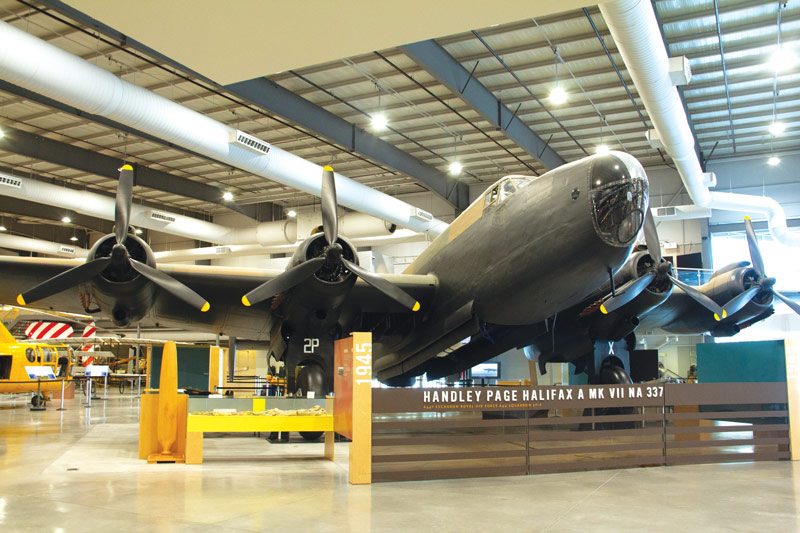
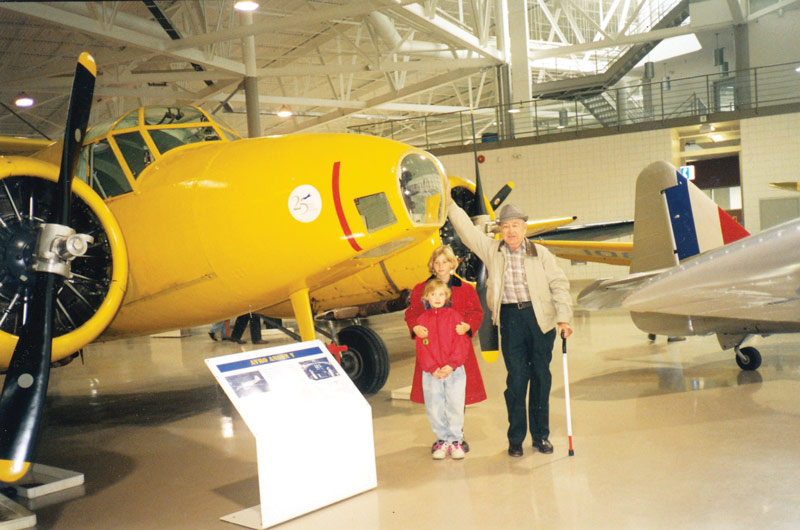
On May 8, 1945, the crew received their operational wings for surviving a full tour of operations.
Smitty wanted to join the military after the war, but by then he was too old. He went home to Centreville and worked as a customs officer until retirement. Meanwhile, McNicholl went on to have a lengthy military career. The aircrew reunited in Winnipeg every four years. Their duties remained top secret for decades after the war.
The Smitty from my childhood has few redeeming traits, but a couple of details upended what I thought I knew about my grandfather—one of which wasn’t caught on tape. Instead, I heard it from McNicholl: the squadron wanted to nominate Smitty for a Distinguished Flying Cross in recognition of his devotion while flying during active duty. Out of the 20,354 DFCs awarded during the Second World War, 4,018 were awarded to RCAF members and 247 were awarded to Canadians in the RAF.
“He said no,” McNicholl told me, “not unless the whole crew gets it.”
The other item that stood out was from my uncle’s interviews with Smitty. When I finished them, I called him.
“I haven’t listened to those for a long time,” he said.
My uncle revealed that he had had very few conversations with his father throughout his life. He had been just as surprised as I was by what he learned in the recorded chats. I told him that by listening to Smitty’s stories, I felt like I understood him better.
“That was part of my hope with those tapes, too,” he said. “That other generations would have some sense of him.”
There is one moment in the recordings when my grandfather revealed a startling truth about himself, one that challenges the assumption that, were it not for the horrors of war, he would have lived a much happier life. The truth is, my grandfather yearned for the existence that most (people in combat) wanted to leave behind.
“The most exciting and happiest time of my life was in the service,” he admitted. “It was the last thing I wanted, was the war to end.”
Advertisement












